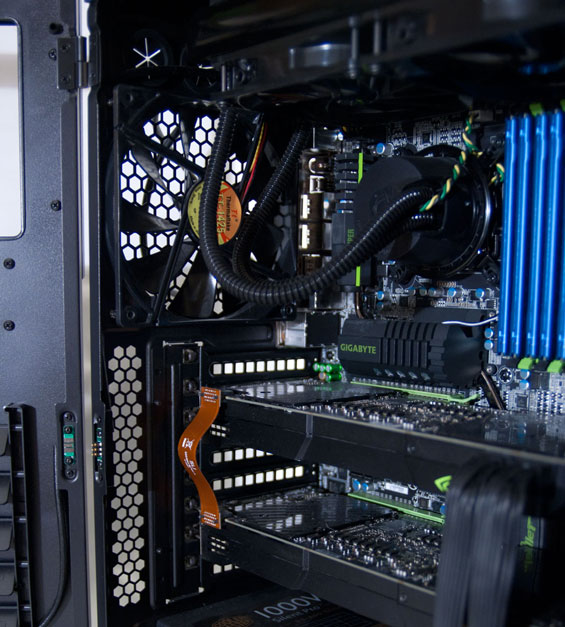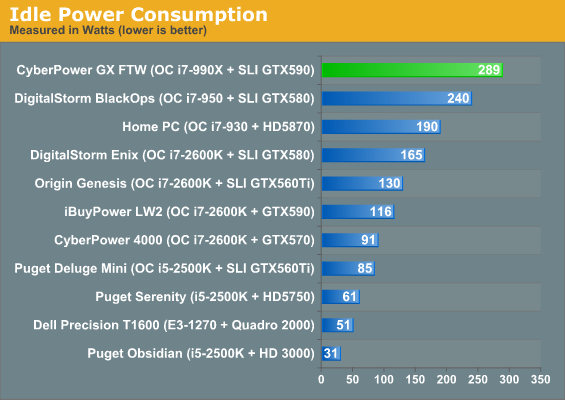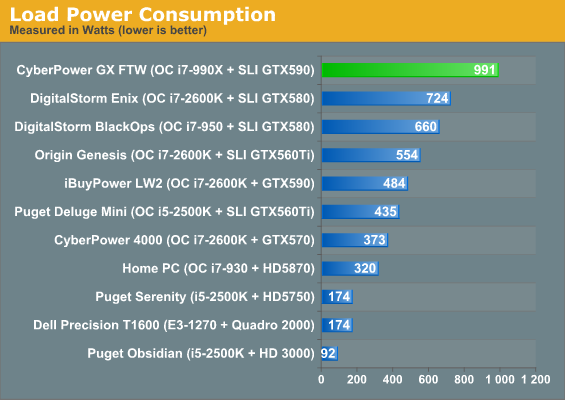CyberPowerPC Gamer Xtreme FTW: Performance at Any Cost
by Dustin Sklavos on June 1, 2011 1:05 PM ESTBuild, Noise, Heat, and Power Consumption
The Thermaltake Level 10 GT's unique engineering does effectively sequester noise and heat, keeping the bulk of it largely well arranged around the CyberPowerPC Gamer Xtreme FTW's processor and video cards. Many of my complaints regarding build quality would be directed more at Thermaltake than CyberPowerPC, but we'll save those for when I tackle the enclosure on its own. Suffice it to say there are a couple of issues with the way the case is designed that are patently unacceptable for an enclosure that costs north of $250.
What CyberPowerPC has understood in its design here is something that I've been experiencing with some of the cases I've reviewed as of late: the number of or size of the fans used in a build is nowhere near as important as it seems. There are at least six fans in the Gamer Xtreme FTW, four alone of which are mounted to the 240mm radiator in a push-pull configuration that exhausts out of the top of the case. But the thing is, if you use a lot of fans, they don't have to work anywhere near as hard as if you try to just use a couple to keep the noise down. Likewise, a single well-placed fan can cool a lot more effectively while not working as hard than if you just place a bunch of fans in your enclosure and call it a day. As a result, the Gamer Xtreme FTW is actually reasonably quiet when idling. It's only under load that it gets noisy, and even then, it's nowhere near as offensive as you'd expect.

The spacing of the two cards is about as optimum as you're going to get, so clearly CyberPowerPC picked the right motherboard for this build. As for heat management, well, take a look for yourself:

Now admittedly I was running the Gamer Xtreme FTW with the sliding glass door open when the outside weather was less than 60F, but we can probably all agree these are excellent thermals, especially when you take into account the reason why I tested this tower with that door open.


That's right, under load it draws nearly a kilowatt. Even idle power is obscenely high. And the Gamer Xtreme FTW dumps all that heat right out in whatever room it happens to be running in. It was during testing this tower that I fully grasped why I could never personally live with a computer like this: it draws an obscene amount of power under load, and that power means it throws a tremendous amount of heat. Those who live in Antarctica or Siberia might appreciate this more than someone in Northern California.
When overclocking and performance tuning, there's generally an inflection point where the processor starts requiring copious amounts of increased voltage with diminishing returns on the core clock. My old i7-930 could hit 4GHz stable on stock voltage, or I could reduce the voltage by 0.075V and still get 3.6GHz. The increased heat (and correspondingly increased noise from the tower having to deal with that much heat) for an extra 400MHz wasn't worth it. A system like this blows right past that inflection point, so under load that processor is going to draw a ridiculous amount of power.
But what about the incredibly high idle current? DigitalStorm was able to run SLI GTX 580s and a heavily overvolted i7-2600K, but the Enix idled at a little over half where the GX FTW sits. The reason for that is simple and one that anyone who's been keeping up with these desktop reviews has probably seen coming: a "badly tuned" overclock. The GX FTW runs its i7-990X at 4.5GHz at all times, with the voltage set at 1.45V. The pair of GTX 590s can idle, but that processor is always going to be drawing a mountain of power. Its idle current is more than some of our test units have pulled under load.
If you're interested in buying a hex-core, quad-SLI, heavily overclocked system for five grand, presumably you have a need for all that performance. In that case, maybe there's an added measure of stability to be had by not worrying about dynamic voltages and multipliers. On the other hand, if you have the FTW powered on just 12 hours per day, sitting idle, your power costs will be around $125 per year (plus the additional cost of AC during hotter months). If you're a professional gamer that "needs" this much performance to stay competitive, and you game eight hours per day to keep your mad skillz sharp, you would bump up your yearly power bill around $300. But I doubt anyone who would actually buy this sort of system will really care about power or cooling costs.
















32 Comments
View All Comments
CyberHD - Friday, June 3, 2011 - link
Meshugge,To better assist us with getting your concerns addressed; please email cyberhd@cyberpowerpc.com with your Cyberpower PC customer id number and a direct return contact number. Once we have this; we will make every effort to contact you to your concerns address your concerns.
Regards
Cyberpower PC
Browngamer93 - Wednesday, June 1, 2011 - link
Don't know too much about computers, but I wouldn't mind playing this impressive material with Crysis 2. Hope I'm the one to win if they have a giveaway.wolfman3k5 - Wednesday, June 1, 2011 - link
This machine looks like it was put together with extreme superficiality, and with an obvious lack of passion. Custom built, boutique computer systems are supposed to be about mods and customizations. Just the cable management is horrendously impractical. If the tech at CyberPowerPC would spend 5 minutes at any Home Depot he could come up with a half way decent cable management solution. When it comes to custom built computer systems, and this price range, everything matters, every little detail. Specs don't matter as much as quality. And I'm addressing this to CyberPower: people don't buy a Ferrari or Lamborghini just for the specs, they also buy them for the status symbol that they get, for the quality and for the level of service. Otherwise everyone could buy a $20000 to $60000 sports car (like a Corvette) and be done with it. I'm not saying that a Corvette is a bad car, I'm just saying that it's not a Ferrari, just like a Alienware will never be a Falcon-NW.My point is that I will never spend this kind of money on a CyberPowerPC or any kind of half-assed-boutique computer system. For $5000 I can get a Mac Pro, an Apple monitor and have money left over for a Macbook. Or I can get a decent PC built by any number of manufacturers that will turn more heads and perform way better.
Bottom line: put some soul in your computers for Christ Sake do some real custom work on them, otherwise your computer systems are just expensive hunks of junks. Most people can twist cables and install boards these days.
EpsilonZero - Thursday, June 2, 2011 - link
For $5000 they really should have managed all of those cables.It looks like they just through the cables in and loosely zip tied them together.
A quality build would have cut and spliced those cables to exact lengths, added sleaves, and changed the plugs to a build enhancing color scheme.
Theres absolutely nothing custom about this build. Everything is stock parts that a customer could very easily purchase from Newegg and as Anand pointed out they could probably save $500 by doing so.
CyberPower you got a long way to go.
ironmb1 - Thursday, June 2, 2011 - link
I love how people on this site cry about how overpriced this rig is, how the hardware is so outdated.. yet they would take it in a heartbeat. All you budget gamers need not apply. Anyways, anyone with this much money willing to spend on a rig with this much hardware... should NEVER EVER buy from CyberpowerPC or Ibuypower. These two companies have HORRIBLE reviews, just go read their forums. There are way better boutique builders than cyberpowerpc, and ibuypower.I love how my password never works more than once. I'm sick of registering to post comments.
MilwaukeeMike - Thursday, June 2, 2011 - link
Anyone else think it was interesting that every hot new SSD is a 240 GB, yet they put 120's in this monster? If anyone could justify 240's it'd be this, right?Or maybe there really isn't anyone who thinks a big SSD is worth the $$$.
GullLars - Thursday, June 2, 2011 - link
Actually, it wouldn't matter much for performance, given the Marvel controller.You would get a lot more bang for buck for this rigg if you got a decent RAID card (like LSI 92xx or Areca 1680/1880) and put up 4-8x 64GB or 128GB SSDs in RAID-0. Your PCmark vantage scores would easily hit 30-35K, IOPS would pass 100K, and bandwidth around 1500-2000MB/s. If you got one of the Arecas with 4GB RAM, the read-ahead and intelligent cache would also make a visible dent in loading times and burst speed.
I would go for a decent RAID card with good SSDs over SLI 590 any day. If you're not going ultra details with 3 27/30" monitors you don't need it anyway.
Single 580 or SLI 560/570 sounds better. I'd also get a water block for the GPU(s) and add another 240/480 radiator (depending on 1 or 2 GPUs), outside the case if needed.
GullLars - Thursday, June 2, 2011 - link
The PCmark Vantage score is way below what you'd expect for a $5K system in Q2 2011.In 2008, Nizzen scored 24740 (just 700 points below this) on a system costing about the same, which was his main system on it's 24/7 clock. This time last year he was in the mid 30K's with a build refresh with 980x also at 24/7 clock.
I suspect the reason for the underperforming score is the Marvel RAID controller used on the motherboard for the SSD RAID, and intel 510 SSDs being used.
I would love to see full PCMark Vantage HDD suite scores to confirm or rule out this.
RAM clock also seems bad, unless running really tight timings.
Gonemad - Friday, June 3, 2011 - link
...for a i7-2600K, (changing all compatible parts accordingly) drop the 590s (quad-core, right?) and try something close to 3-slot SLI /CF models/setup, with unencumbered multipliers on the graphics cards and on the CPU, add more water cooling, drop more fans, and see what happens to bang-for-buck and idling power. Most oldish games still enjoy poor coding and like faster cores instead of MORE cores, like SC2.And really, for that dosh all the cabling should be custom-fit.
7Enigma - Monday, June 13, 2011 - link
What the heck does this mean:"Now admittedly I was running the Gamer Xtreme FTW with the sliding glass door open when the outside weather was less than 60F, but we can probably all agree these are excellent thermals, especially when you take into account the reason why I tested this tower with that door open."
So you tested with the sliding glass open because your ambient temp was cool. How does that have any resemblance to normal operating conditions? All the dust, increased noise, not to mention very likely giving a VERY rosy picture to the thermals. It doesn't matter if the problem is the Thermaltake Level 10 GT as you allude to without giving specifics, Cyberpower CHOSE this case for this build. If they made the wrong case choice, that IS on them.
Dustin, I normally like your reviews and writing style, but this one smacks of bias or poor decision making.